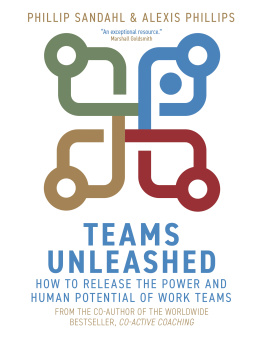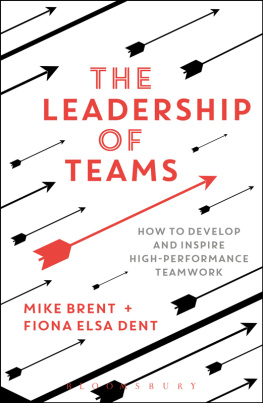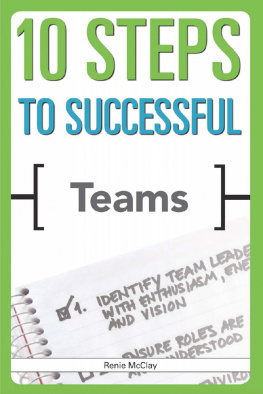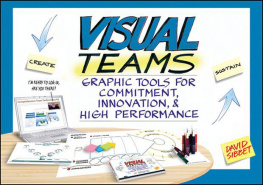Making Teams Work: How to Form, Measure, and Transition Todays Teams
Making Teams Work: How to Form, Measure, and Transition Todays Teams
Donna Deeprose

Excerpts from interviews conducted by the author with the following individuals are published with permission:
William Becker, Strategic Business Resources
Jeff Ward, Celestica
Karen Massoni, Organizational Development Consultant
Bart Stanco, Karen Cone, and Megan Taylor, Gartner
Michael Hillis and Terry Everett, Advanced Micro Devices, Inc.
Mark Samuels and Murray Louis, SEI Investments
Donna Wies, Andy Morrison, David Livingston, and Roger Ham, Union Sanitary District
Sherri Lindenberg, AXA Client Solutions
Material in this course has been adapted from:
Recharge Your Team: Keep Them Going (An AMA Management Briefing), by Donna Deeprose, et al. Copyright 1998 AMA Publications, a division of the American Management Association International, New York, NY. Used by permission. All rights reserved. http://www.amacombooks.org
The Team Coach: Vital New Skills for Supervisors and Managers in a Team Environment. Copyright 1995 Donna Deeprose. Published by AMACOM, a division of the American Management Association International, New York, NY. Used by permission of the publisher. All rights reserved. http://www.amacombooks.org
2001 American Management Association. All rights reserved. This material may not be reproduced, stored in a retrieval system, or transmitted in whole or in part, in any form or by any means, electronic, mechanical, photocopying, recording, or otherwise, without the prior written permission of the publisher.
Printed in the United States of America.
10 9 8 7 6 5 4 3 2 1
Contents
About This Course
Making Teams Work: How to Form, Measure, and Transition Todays Teams is the introductory course in AMAs self-study program on teamwork and teams. The purpose of this course is to help you achieve identified business objectives through the vehicle of teams. This course is useful for team members at all levels, whether you are the leader of a team, its sponsor, or an active team member. Whatever your role, you will gain practical knowledge about the various kinds of teams your organization can use, the situations each type of team is best suited for, the problems each can solve, and the conditions necessary for their success. Whether your interest is in maximizing the performance of a single cross-functional project team or in helping work unit teams succeed across your organization, youll find role models in real-life examples from successful companies. Applying team-tested techniques, you will develop skills for setting measurable goals, leading and participating in teams, overcoming obstacles to goal accomplishment, measuring team effectiveness, and handling team transitions. With these skills in place, your organization will be prepared to use its teams productively to accomplish its business goals.
Donna Deeprose is a management and organization development consultant and business writer with over 20 years experience in the fields of executive, management, and employee development and business teams. The author of three books, The Team Coach, Recharge Your Team, and How to Recognize and Reward Employees, she is a frequent conference speaker on these topics. She is also a regular contributor to business periodicals and web sites.
As a consultant and trainer, Deeprose focuses on helping people understand the practices that limit their performance, identify changes needed to accomplish their individual and organizational best, and determine ways to cooperate with others to make those changes happen. She holds a masters degree in journalism from Columbia University and another in educational psychology from Fordham University. Her B.A. is from the University of Alberta.
A CKNOWLEDGMENTS
The publisher would like to thank the following people for their review of the manuscript of this course:
Vicki Davis, Organizational Development & Training Manager, AEGON, Louisville, Kentucky
Vivette Payne, consultant and writer specializing in organization, team, and personal development; author of First Level Leadership: Supervising in the New Organization (American Management Association, 1998) and The Team-Building Workshop: A Trainers Guide (AMACOM, 2000).
How to Take This Course
This course consists of text material for you to read and three types of activities (the pre- and post-test, in-text exercises, and end-of-chapter review questions) for you to complete. These activities are designed to reinforce the concepts introduced in the text portion of the course and to enable you to evaluate your progress.
P RE- AND P OST -T ESTS
Both a pre-test and post-test are included in this course. Take the pre-test before you study any of the course material to determine your existing knowledge of the subject matter. Submit one of the scannable answer forms enclosed with this course for grading. On return of the graded pre-test, complete the course material. Take the post-test after you have completed all the course material. By comparing results of the pre-test and the post-test, you can measure how effective the course has been for you.
To have your pre-test and post-test graded, please mail your answer forms to:
Educational Services
American Management Association
P.O. Box 133
Florida, NY 10921
All tests are reviewed thoroughly by our instructors and will be returned to you promptly.
.
American Management Association. All rights reserved.
http://www.amanet.org/
T HE T EXT
The most important component of this course is the text, where the concepts and methods are presented. Reading each chapter twice will increase the likelihood of your understanding the text fully.
We recommend that you work on this course in a systematic way. Reading the text and working through the exercises at a regular and steady pace will help ensure that you get the most out of this course and retain what you have learned.
In your first reading, concentrate on getting an overview of the chapter content. Read the learning objectives at the beginning of the chapter first. They will act as guidelines to the major topics of the chapter and identify the skills you should master as you study the text. As you read the chapter, pay attention to the headings and subheadings. Find the general theme of each section and see how that theme relates to others. Dont let yourself get bogged down with details during the first reading; simply concentrate on understanding and remembering the major themes.
In your second reading, look for the details that underlie the themes. Read the entire chapter carefully and methodically, underlining key points, working out the details of examples, and making marginal notes as you go. Complete the activities.
A CTIVITIES
Interspersed with the text of each chapter you will find a series of activities. These can take a variety of forms, including essays, short-answer quizzes, or charts and questionnaires. Completing the activities will enable you to try out new ideas, practice and improve new skills, and test your understanding of the course content.
Next page








